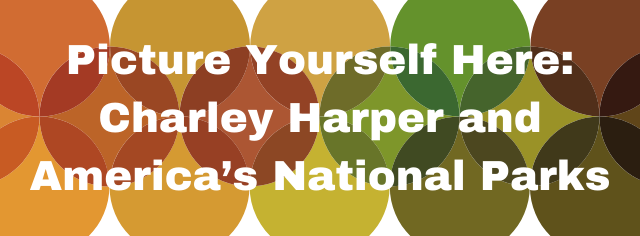Charley Harper (1922-2007) was a famed, wildlife illustrator best known for his geometric, whimsical interpretations of nature. Later, Harper would refer to his artistic style as minimal realism. With technical drawing tools such as French curves, compasses, and straight-edges in hand, Harper created illustrations of his subjects that included what he thought were the most important features nothing more. As he developed his unique style, his interests in wildlife and conservation grew.1 Explaining his style, Harper remarked, “When I paint a bird, I paint the wing, not the feathers.”2 Though Harper’s style didn’t influence the world of fine art, his works did have a major impact on design and have been mass-produced and sold through an extensive variety of products from prints to books, puzzles, and more.3 One can see this vast array of products through authorized dealer websites such as, Charley Harper Prints.
Born in Frenchton, West Virginia, Harper left his family farm to attend the Art Academy of Cincinnati in Ohio.4 Through his education at the Academy, Harper learned and practiced realism in his art but felt it offered nothing new for the subject or viewer and limited his desire to include commentary. Often referred to as the “anti-Audubon” wildlife artist for his lack of realism, Harper referred to photographs and illustrations from books, magazines, and field guides for his inspiration as he was unable to draw while also observing.5 Harper met his wife, Edie McKee, who was also a talented artist, on the first day of classes at the Art Academy of Cincinnati. In the midst of their education, however, WWII broke out. While Charlie was drafted into the Army serving as a scout, Edie contributed to the war effort on the homefront as a photographer for the Army Corps of Engineers.6
Following the war, the Harpers graduated in 1947, soon married, and later had one son, Brett Harper. The honeymooners enjoyed a 6-month road trip mostly across America’s southwest which influenced their life-long focus on artistic interpretations of nature.7 After living for a brief stint in New York, the Harpers returned to Cincinnati where Charley began a career in commercial illustration. Selling one of his paintings to Arthur Lougee, The Ford Times magazine art director, Charley Harper’s career took a turn from creating advertisements for beauty products to illustrating over 30 years for The Ford Times. Due to his work with The Ford Times and sales of his art, Harper’s success garnered a commission to illustrate the Giant Golden Book of Biology (1961) and The Animal Kingdom (1968).8
Despite his lack of a scientific background, the scientific community lauded Harper’s artwork for its minimal approach and accuracy. Harper’s career continued with commissions from science museums, university science departments and labs (e.g., the Cornell Laboratory of Ornithology), research centers (e.g., Byrd Polar Research Center at The Ohio State University), scientific journals, state parks, and the U.S. National Park Service.9
This image gallery presents a portion of Harper’s commissioned work by the U.S. National Park Service and related maps. Prints of these works in poster format as well as the maps which relate to the geographic areas represented in Harper’s artwork are owned by the University of Kentucky Libraries and have been digitized by the UK Libraries’ Special Collections and Research Center.
Take a moment to explore Harper’s renowned, commissioned artwork and the corresponding, curated collection of maps in the galleries linked below.
Notes:
1. Halpern, Megan K., and Hannah Star Rogers. "Inseparable Impulses: The Science and Aesthetics of Ernst Haeckel and Charley Harper." Leonardo 46, no. 5 (2013): 467-468.2. Mitchell, Charles D. "Charley Harper, The Public Trust." Art in America, Oct. (2009): 174.
3. Halpern and Rogers, 467.
4. Wikipedia. "Charley Harper." Last edited January 28, 2020. Accessed April 3, 2020. https://en.wikipedia.org/wiki/Charley_Harper.
5. Halpern and Rogers, 468.
6. Halpern and Rogers, 467; Wikipedia. "Charley Harper." Last edited January 28, 2020. Accessed April 3, 2020. https://en.wikipedia.org/wiki/Charley_Harper; and Wikipedia. "Edie McKee Harper." Last edited December 9, 2019. Accessed April 3, 2020. https://en.wikipedia.org/wiki/Edie_McKee_Harper.
7. Wikipedia. "Charley Harper." Last edited January 28, 2020. Accessed April 3, 2020. https://en.wikipedia.org/wiki/Charley_Harper; and Wikipedia. "Edie McKee Harper." Last edited December 9, 2019. Accessed April 3, 2020. https://en.wikipedia.org/wiki/Edie_McKee_Harper.
8. Halpern and Rogers, 467; and Wikipedia. "Ford Times." Last edited November 25, 2017. Accessed April 3, 2020. https://en.wikipedia.org/wiki/Ford_Times.
9. Halpern and Rogers, 468.
Browse the US National Parks Collections:
US National Parks Gallery 1 - Atlantic Barrier Islands
US National Parks Gallery 2 - Coral Reef
US National Parks Gallery 3 - Rocky Mountains
US National Parks Gallery 4 - Alpine Northwest
US National Parks Gallery 5 - Sierra Range
US National Parks Gallery 6 - Glacier Bay


